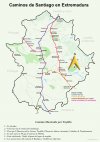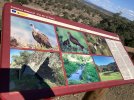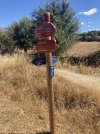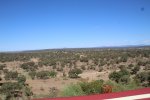Camino Mozárabe Variante via Trujillo:
I just walked this variante in March. Here is some information on my stages which may help others interested in this alternative to walking the Mozarabe to Merida. I mostly followed the recommendations of Jose Antonio Ortega Ruiz, who has the Facebook site Camino Mozarabe Por Trujillo, and is a strong proponent of this route.
I used the mapy.cz app which has this variant on the map, so I could always easily check the route. Marking was never excessive, and was a variety of different types, rarely yellow arrows, meaning some sort of GPS system was very helpful. The facebook site has a link to a map with GPS which looked easy to use, though I didn’t use it.
My stages were shorter than my usual because it was extremely hot with fierce sun this March for me, an Alaskan. I could not walk well after 1pm as the day got hotter and hotter.
The PDF guide available on the Facebook site was very helpful for route description, and contact information for accommodation. Reading Maggie’s account on this forum from 2018 was also helpful. I also used the Mundicamino information, though some was outdated.
Starting from Castuera, Jose Antonio recommends taking the shortcut direct to Magacela (27 km), not passing Companario (35 km). This would involve staying in Magacela at the highly recommended Casa Rural El Cercon, but it was full and calling the town hall in Magacela for alternatives drew a blank.
So my stages were as follows:
Day 1. Castuera to Campanario. 21 km. I stayed in the polideportivo at the far end of town, in a room with 3 bunk beds with comforters, a great shower in the one bathroom, and a refrigerator. No microwave. It is simple but perfectly adequate. Donativo. I got the key from the friendly and helpful policia across the street, after calling the day prior. There is no bar anywhere nearby that opens early for coffee, but there is a friendly bar just up the street and a menu del dia at the restaurant at the preceding intersection for food and drink in the afternoon/evening.
Day 2. Campanario to Villanueva de la Serena. 26 km. The first 13.9 km to Magacela are open country, grand vistas of rolling hills always with the hill and castle of Magacela visible ahead. Just outside of Magacela I visited the dolmen site, worth doing. The route on from Magacela to Villanueva de la Serena is 12.3 km on gravel country roads with almost no traffic over the rolling hills, green with wheat in March. There is no shade. What signage I saw was the white marks for the Camino Guadalupe. In Villanueva de la Serena I stayed at El Emigrante Hotel, 34 euros, a fine family run hotel in the center of the city. There is no albergue. The hotel bar does not open at 7am as advertised, but does have a 12 euros menu del dia in the afternoon, and there are bars nearby that are open by 7am.
Day 3. Villanueva de la Serena to Puebla de Alcollarin. 19 km. A very flat day, first on a via verde, then on the long viaduct over the Rio Guadiana, then along dusty gravel roads. I had a coffee in Rena in a bar in town, not the one at the entrance of the village which is closed. Rena and all the villages of these plains are planned resettlement villages from 40 or 50 years ago when the land was opened up for irrigated agriculture. After Rena one follows the irrigation channel A-XVII. No need for arrows or other indicators. In Puebla de Alcollarin I got the key for the Salon Parroquial from the ayuntamiento where I was warmly greeted by Erika. The parish center on the plaza, next to the church, had a large meeting/activity room and a small room, which I made my own. There were 3 mattresses, twin size, very thick, very good quality, so I had a super comfortable night sleeping on my mattress on the floor. There were clean sheets, and comforters. There was a microwave in the large room. There was no shower, though the woman at the ayuntamiento told me she could arrange a shower for me if I desired. I made do with hot water, heated in the microwave, and used a basin for a sponge bath. It is a donativo and one leaves one’s donation next to the microwave. The one local bar had some food and everyone was very warm, friendly and welcoming. I got a takeout coffee from the bar for the next morning, as the bar doesn’t open early. There was also one very small grocery store, a tobacco store well stocked with candy, and a pharmacy, all on the plaza.
Day 4. Puebla de Alcollarín to Abertura. 19 km. The first 13 km continued to be flat and dusty, again following the route of the irrigation channel A-XVII. There were large trucks and farm equipment harvesting what I think might have been wheat. The irrigated rice fields were being prepared for planting. The plum and almond trees were in bloom. The final km were at the side of the asphalt road up into the hills. After more than a day of “planned” villages laid out in rectangular blocks, it was refreshing to walk into Abertura, an old village with narrow curvy streets. The central plaza has the ayuntamiento, a bar not serving food, a grocery store open most mornings and briefly in the evening, the playground for young children, and directly behind the playground, the community multi-use building. The woman in the ayuntamiento walked me across the plaza to this building, and showed me my bed in the corner of the building’s one large room, a stage at one end, and exercise equipment along 2 walls. This was my ‘albergue’. It had the advantage of my being able to watch the evening exercise class, chat with all the folks coming in through the evening to run, spin, and lift weights. If I had needed more exercise, I could have had a real work-out. By 9:30 pm they had left and I could sleep. The building had one bathroom, no shower, but the woman at the town hall drove me to the municipal pool at the edge of the town for a fabulous strong hot shower shortly after I arrived. So this was a simple place, no kitchen, but very welcoming. The church was open, beautiful, with a small statue of Santiago, and the women visiting there were happy to quiz me on my motivations on walking a pilgrimage. This is another one of these towns with 200 some inhabitants and a dozen or so children in the school, where all are pleased to be able to offer accommodation to a pilgrim. Donativo, no place to leave money, but I wrapped the key in a bill, and put it in the yellow post box next to the ayuntamiento as instructed when I left in the morning. The bar, not really open in the afternoon when I had stopped by, cheerfully made me a take out coffee for the morning.
Day 5. Abertura to Trujillo. 24 km. The scenery changes completely. All day was on a Via Pecuaria, one of the drover’s routes in Spain, first briefly on a paved road, then a white dirt/gravel road, then a rough track passable by tractors, and then barely a trail, more a choice of cow paths, easy to follow because it was always bordered by either stone walls or fences. Again no need for yellow arrows. I saw 2 cars and 1 cyclist all day. Huge granite boulders, hills, wild flowers everywhere, sheep and cows. Mud. The roman bridge towards the end of the day was striking. Then up over a hill and Trujillo appears just ahead. I stayed in Hotel Hueso, 34 euros, which was fine, and just a block from the plaza. There may be simple pilgrim accommodation near the entrance of town which I did not investigate; it may be closed. Jose Antonia Ortega recommended Hotel Hueso, (or Hotel Julio) so I chose one of those. The gazpacho and moraga (seared chunks of meat on a bed of lettuce) were a delicious part of the hotel’s menu del dia. Trujillo is an historic place, swarming with Spanish tour groups, and very impressive. I visited the Iglesia de Santiago, which is now a museum featuring the work of Spanish artist and musician Jaime de Jaraiz. It has a statue of Santiago as part of the altarpiece and is a lovely church.
Day 6 Trujillo to La Aldea del Obispo. 14km. As this was a very short day (the alternative was 41 km) I slept in, had the hotel breakfast at 8 am, and walked about the historic part of town a bit more, before leaving town. This was a day of walking on the broad shoulder of the asphalt road EX-208. The guide argues that this shoulder is broad and the traffic light. I found the traffic heavier than I liked, and the shoulder not that broad, but it was what it was. At km 69.2, one has the option of going off asphalt to the left, initially on a track suitable for a 4 wheel drive vehicle, which stops after ¼ km at a gate. From there on it is a matter of making your own route literally, the last 6 km to La Aldea del Obispo. The initial terrain is granite boulders, and fairly dense undergrowth of flowers, shrubs and small trees. There are no cow or sheep paths. Down on the plains below is dehesa with widely spaced holm oak trees and pastures. It is quite beautiful, and if I had had a companion, I think I would have tried to walk it. But alone, no longer young, with no defined trail, not being able to see my destination, not knowing if the VP (Via Pecuaria) markers continued clearly, not knowing if there would be fences to climb over, I returned to the highway. I also did not have a wikilocs on my phone defining this particular 6 km stretch, and mapy.cz did not map this either. So back to the highway and approaching La Aldea del Obispo just before 1pm, my scheduled arrival time arranged on the phone with the ayuntamiento the day before, a car stopped, asked if I was the pilgrim and invited me to jump in and ride the last quarter km into town, to the home of the woman I was scheduled to me, Senora Petri. What a welcome. She walked me to the bar to introduce me to the owner, where a meal was arranged for me later in the day, walked me to the 2 tiny groceries stores and then to the Casa De Peregrinos, an entire 2 bedroom house, with sitting room, full kitchen, lovely bathroom with tub and shower, interior patio with clotheslines and pins, clean sheets and towels. Donativo. The last pilgrim who had stayed there was a Spaniard 10 days earlier. Petri said I was the first solo woman who had ever stayed there. It is just down the street from the casa rural where Maggie stayed. Such a welcome in a tiny village. As I walked around in the cooler evening, everyone seemed to know I was the pilgrim staying in their Casa De Peregrinos and it was clear that all were proud of what they had to offer pilgrims.
(continuing below...)




















